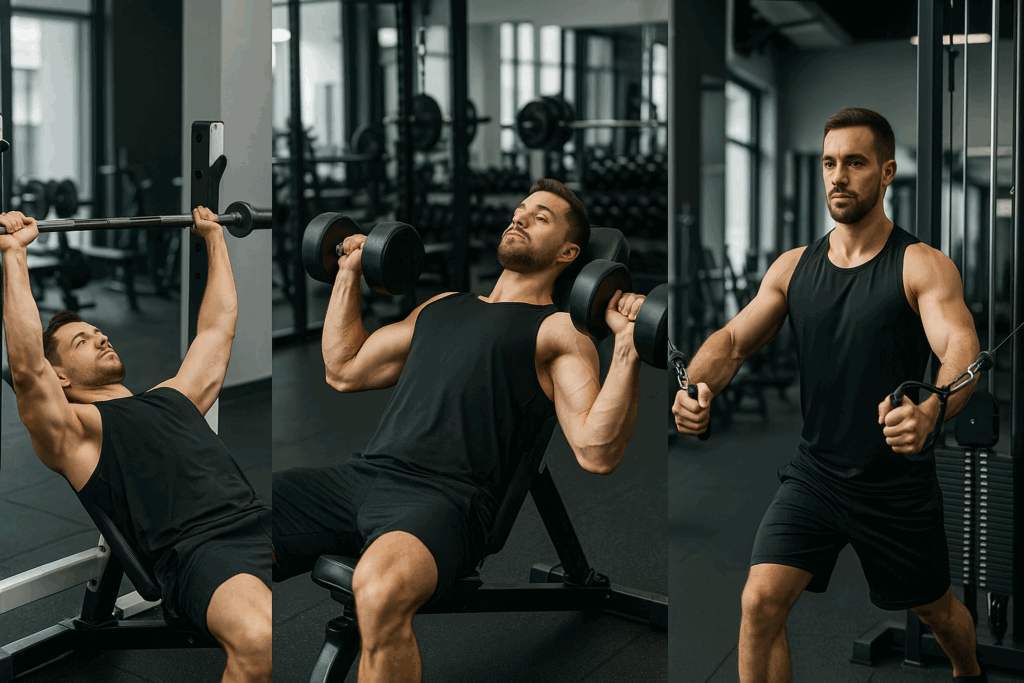Introduction: Unpacking the Mystery of Muscle Group Training
Understanding how many muscle groups should you train per workout is one of the most pivotal decisions you’ll make when designing a strength-training regimen. This decision influences not only how quickly you build muscle and strength, but also how efficiently you recover, how long your sessions last, and even how motivated you stay over time. The question isn’t simply academic; it cuts to the core of programming strategies that balance physiological adaptation, neuromuscular engagement, and metabolic efficiency.
While some lifters swear by split routines targeting one muscle group per session, others prefer full-body workouts engaging multiple groups simultaneously. Still others use hybrid models that change focus depending on training phases. In this comprehensive guide, we’ll unpack the science, theory, and real-world application behind optimizing your training split. We’ll also look at key variables like how many exercises per muscle group, how many workouts per muscle group per week, and how these decisions affect long-term progression.
You may also like: The Ultimate Hypertrophy Workout Program for Building Strength and Size

The Physiology Behind Muscle Growth
To understand the impact of training multiple muscle groups per session, it’s important to grasp the biological processes underpinning muscle hypertrophy. When you train, you induce microscopic damage in muscle fibers, triggering a cascade of hormonal and cellular responses. This includes the release of growth hormone, testosterone, and insulin-like growth factor 1 (IGF-1), all of which contribute to protein synthesis and muscle repair.
Training more muscle groups per session can amplify this hormonal surge. Compound movements like squats, deadlifts, and bench presses engage multiple large muscle groups, creating a systemic response that promotes overall muscle growth. However, this comes with increased demands on the central nervous system (CNS) and recovery mechanisms. Therefore, the number of muscle groups trained per session should be matched to your recovery capacity, which varies by age, nutrition, sleep quality, and training experience.
The Science of Exercise Volume and Frequency
A key variable in resistance training is volume—the total amount of work performed, typically measured as sets × reps × load. Research shows that higher training volumes generally result in greater hypertrophy, but only up to a point. More isn’t always better, particularly if recovery is compromised. This is where the concepts of frequency and muscle group distribution become essential.
If you train multiple muscle groups in a single session, you can distribute volume more evenly across the week. For example, instead of hitting chest with 20 sets in one session, you might split it into 10 sets across two sessions, improving quality and reducing fatigue. This approach often leads to better outcomes than overwhelming a single muscle group in a marathon session.

How Many Muscle Groups Should You Train Per Workout? Exploring Effective Splits
When considering how many muscle groups should you train per workout, the answer often depends on your training experience and goals. Beginners benefit from full-body workouts that train most or all major muscle groups three times per week. This high-frequency exposure accelerates neuromuscular adaptation and skill acquisition, laying a solid foundation.
Intermediate and advanced lifters often shift to upper-lower or push-pull-legs (PPL) splits. These allow for higher per-session volume per muscle group, while still maintaining effective weekly frequency. For example, a push day might train chest, shoulders, and triceps—three synergistic muscle groups that support pressing movements. This setup not only enhances muscle coordination but also streamlines workout duration and intensity.
Ultimately, training two to three muscle groups per session tends to be a sweet spot. It allows sufficient stimulus without overwhelming recovery capacity. Whether you’re training chest and back together, or grouping legs and core, the goal is to create synergy between muscle groups that share movement patterns or recovery profiles.

Practical Guidelines for How Many Exercises Per Muscle Group
Once you’ve decided on how many muscle groups to train, the next question becomes: how many exercises per muscle group should you perform in each session? Current research and expert consensus suggest that two to three exercises per muscle group is optimal for most individuals. This allows for targeting the muscle from different angles, incorporating both compound and isolation movements.
For instance, a chest-focused session might include the bench press (compound), incline dumbbell press (angle variation), and cable fly (isolation). This ensures comprehensive fiber recruitment without excessive fatigue. When applying this across multiple muscle groups in one session, strategic planning becomes vital. You want to avoid doing so many total exercises that you dilute focus or compromise form.
Moreover, the selection of exercises should reflect your goals. If strength is the primary focus, compound barbell lifts should dominate. If hypertrophy is the aim, a broader variety including machines and dumbbells can enhance muscle tension and metabolic stress.

Balancing Intensity and Recovery
Training multiple muscle groups per session intensifies systemic fatigue. This means recovery must be equally strategic. The more muscle groups you train in one workout, the greater the demand on the CNS, muscular glycogen stores, and hormonal systems. Without proper recovery, you risk stagnation or overtraining.
Recovery is influenced by several modifiable factors. Nutrition plays a critical role; adequate protein and calorie intake supports muscle repair. Sleep quality directly impacts hormonal regulation, especially testosterone and growth hormone levels. Stress management, hydration, and active recovery techniques like stretching and foam rolling also play significant roles.
Thus, if you’re training two or more major muscle groups per session, it’s important to incorporate rest days and periodization techniques into your plan. This might include deload weeks, reduced intensity phases, or alternating high- and low-volume cycles to allow the body time to adapt.

Strategic Approaches: How Many Workouts Per Muscle Group Per Week?
Determining how many workouts per muscle group per week is optimal depends largely on your training split and individual recovery. The scientific consensus generally favors training each major muscle group two to three times per week for optimal growth. This aligns well with the idea of training multiple muscle groups per session, as it allows for repeat stimulation while managing fatigue.
For example, an upper-lower split performed four days per week hits each muscle group twice. A PPL split done six days per week can hit each muscle group twice if the cycle is repeated over seven or eight days. This frequency helps maximize muscle protein synthesis, which peaks about 24–48 hours after a session. By spacing workouts appropriately, you can keep synthesis elevated throughout the week.
Athletes focused on strength may benefit from lower frequencies with higher loads, while bodybuilders often prefer moderate frequency with higher volume. The key is to match training frequency with your recovery rate and desired outcomes, ensuring consistent progression without burnout.
Intelligent Programming: Periodization and Variation
Effective programming isn’t just about how many muscle groups should you train per workout; it’s about how you cycle intensity, volume, and focus over time. Periodization is the systematic planning of training variables to optimize performance and recovery. This may include linear periodization (gradually increasing intensity), undulating models (frequent variation), or block periodization (phases focusing on different attributes).
Incorporating variation in muscle group pairing is another way to promote adaptation. One week you might pair chest and triceps, while the next week it’s chest and back. This not only prevents monotony but also introduces new neuromuscular challenges that stimulate growth. Importantly, this variation should be purposeful rather than random, aligned with your goals and recovery profile.
Periodization also allows for built-in recovery. Deload weeks reduce volume or intensity to prevent overtraining. Transition phases between hypertrophy and strength cycles ensure structural and neurological readiness. These tactics collectively support long-term sustainability and progress.

Understanding the Role of Compound Versus Isolation Movements
When training multiple muscle groups in one session, exercise selection becomes critical. Compound movements, which engage multiple joints and muscle groups, are highly efficient for building overall strength and mass. These include exercises like squats, deadlifts, overhead presses, and rows. They not only save time but also stimulate greater hormonal responses.
However, relying solely on compound lifts can neglect smaller stabilizing muscles and limit muscle symmetry. This is where isolation exercises come in, allowing you to target specific muscles with precision. For example, adding lateral raises after overhead presses ensures comprehensive shoulder development.
When deciding how many exercises per muscle group, include a mix of compound and isolation lifts. A balanced routine might begin with heavy compound lifts for strength, followed by isolation work to induce metabolic stress and refine weak points. This approach maximizes muscle recruitment while supporting structural balance.
Periodic Assessments and Individualization
Every lifter is different, and the most effective training programs are those tailored to individual needs. Factors like limb length, mobility, injury history, and lifestyle all influence how many muscle groups should you train per workout. Periodic assessments help refine your strategy. These might include strength testing, body composition analysis, or movement screens.
Tracking progress through training logs or apps also aids in identifying plateaus or overtraining signs. If performance declines or recovery lags, it may be time to reduce the number of muscle groups per session or add a rest day. Conversely, if progress is rapid and recovery feels solid, increasing volume or frequency could accelerate gains.
Listen to your body, but also rely on data. Combining subjective feedback with objective metrics enables smarter programming decisions. Remember, muscle building is both art and science—a dynamic interplay between stimulus, recovery, and adaptation.
The Neurological Dimension of Training Multiple Muscle Groups
Beyond the muscular system, training multiple muscle groups engages the nervous system in complex ways. Coordinated compound lifts require refined motor patterns, proprioceptive control, and intermuscular communication. For newer lifters, training several groups at once can accelerate these neuromuscular adaptations, enhancing overall athleticism.
However, neurological fatigue accumulates quickly. Overloading the CNS can blunt force production, reduce motor unit recruitment, and even impair sleep quality. Balancing CNS load is especially important for advanced athletes, where training intensity and complexity are high.
Rotating the focus of muscle groups across sessions helps manage neurological load. For instance, a heavy leg day might be followed by a moderate upper body pump session. By alternating neural demand, you create space for recovery while maintaining training consistency.
Frequently Asked Questions: How Many Muscle Groups Should You Train Per Workout
What are the psychological benefits of training multiple muscle groups per workout?
Training multiple muscle groups in a single session can have profound psychological benefits that extend beyond physical adaptations. For many individuals, achieving a full-body pump enhances feelings of accomplishment and boosts motivation. This holistic approach can make workouts feel more productive, leading to improved adherence to training schedules over time. Engaging different muscle groups also promotes mental stimulation by reducing monotony, especially for those who struggle with routine-based boredom. Additionally, the elevated endorphin response from training more extensively contributes to reduced anxiety, sharper focus, and better mood regulation, supporting long-term mental well-being.
How can you adapt your training if you’re time-constrained but still want maximum gains?
When time is limited, prioritizing compound exercises that target multiple muscle groups simultaneously becomes essential. Movements like squats, deadlifts, and pull-ups allow for effective muscle recruitment while minimizing time spent transitioning between exercises. Supersets, tri-sets, and circuit training also allow you to cover more ground in less time without sacrificing intensity. Reducing rest intervals strategically can help maintain training volume, provided the form and load are preserved. With careful selection and sequencing, it is possible to efficiently stimulate two to three muscle groups per workout in just 45 minutes while still progressing toward hypertrophy or strength goals.
How many exercises per muscle group are optimal for different training goals?
The answer varies depending on whether the goal is hypertrophy, endurance, or strength. For hypertrophy, performing two to three exercises per muscle group allows for fiber recruitment across multiple angles and ranges of motion. In contrast, for strength development, fewer exercises with higher intensity may be more effective, often limited to one or two foundational compound lifts. For endurance or metabolic conditioning, high-rep isolation movements may be used alongside compound work to support muscular fatigue resistance. The volume of how many exercises per muscle group also depends on weekly frequency—those training a muscle more frequently may require fewer exercises per session to avoid overtraining. Ultimately, your goal dictates your optimal setup.
How many workouts per muscle group are ideal for maximizing growth?
Recent sports science literature consistently suggests that training each muscle group two to three times per week offers optimal muscle growth for most individuals. This frequency provides repeated anabolic signaling while allowing for adequate recovery between sessions. Athletes with enhanced recovery capacities, such as younger lifters or those with supportive nutrition and sleep, may tolerate up to four sessions per muscle group weekly under periodized models. In contrast, lifters with older training age or higher systemic stress loads may benefit from fewer sessions with higher per-session volume. Understanding how many workouts per muscle group suit your physiology requires tracking not just gains, but also markers like soreness, energy levels, and motivation.
How does training multiple muscle groups affect neuromuscular coordination?
Training more than one muscle group per session enhances neuromuscular efficiency by promoting coordination between different systems. For example, during exercises like bent-over rows or clean and press, the central nervous system learns to synchronize multiple joints and motor units for optimized movement. Over time, this leads to better proprioception, balance, and reactive strength. Advanced lifters often manipulate muscle group combinations strategically to develop these skills, such as pairing core work with compound lifts. In this context, choosing how many muscle groups should you train per workout becomes not just about size, but also about sharpening movement quality and functional athleticism.
Is it ever beneficial to train only one muscle group per workout?
Yes, in specific contexts such as advanced bodybuilding or injury rehabilitation, training just one muscle group per workout can yield benefits. For competitive bodybuilders, this allows for high-volume isolation training that targets every fiber and minimizes neural overlap. This strategy is also valuable during pre-contest phases when precision sculpting and symmetry are the focus. In rehabilitation, isolating a recovering muscle helps control load and avoid compensatory patterns. However, this approach requires superior recovery management and often involves splitting the week into six or seven sessions to maintain overall balance.
How many exercises per muscle are appropriate for injury prevention and joint health?
When prioritizing joint health and injury prevention, exercise selection should emphasize controlled movement patterns and balanced development. Typically, one to two exercises per muscle with meticulous form and moderate intensity is sufficient. Stability-focused movements like single-leg Romanian deadlifts or scapular retraction drills enhance neuromuscular awareness without overwhelming the joints. Rotator cuff strengthening, glute medius activation, and unilateral work can be integrated to offset common imbalances. In such cases, determining how many exercises per muscle isn’t just about volume—it’s about quality and purpose.
How do training age and experience influence how many muscle groups should you train per workout?
As training age increases, your capacity to generate intensity improves, often necessitating fewer muscle groups per session to maintain focus and recovery. Novices may benefit from training multiple groups due to the lower absolute loads they can handle, which reduces CNS fatigue and accelerates adaptation. Intermediate lifters might benefit from two to three muscle group combinations to balance growth and performance. Advanced athletes often split their programming more narrowly to optimize recovery, neuromuscular precision, and structural balance. Tailoring how many muscle groups should you train per workout based on training age ensures sustainable progress and reduced injury risk.
How do environmental and lifestyle factors affect workout structure?
Factors like job stress, sleep quality, and dietary consistency significantly influence how many workouts per muscle or muscle group you can handle weekly. For example, a shift worker with irregular sleep may require fewer sessions per week with reduced training volume to preserve recovery. Those with physically demanding jobs may benefit from alternating muscle group focus to avoid overlapping stress on commonly used areas. Environmental constraints, such as equipment availability or home gym limitations, also affect how many muscle groups should you train per workout. Adapting your split to life’s variables ensures training remains consistent and effective without leading to burnout.
How can you apply periodization to manage how many muscle groups should you train per workout?
Periodization offers a structured way to vary muscle group training based on phases of intensity, volume, or recovery. During a hypertrophy phase, you might train three muscle groups per session using moderate loads and shorter rest periods. In a strength cycle, you might reduce it to one or two groups with heavy loads and longer rests to preserve CNS output. Deload weeks can reintroduce full-body sessions to support systemic recovery. This cyclical adjustment helps you manage how many workouts per muscle you perform monthly while aligning with overarching fitness goals. Thoughtful periodization makes your muscle group training strategy more adaptable and effective long term.
Conclusion: Synthesizing Strategy for Optimal Gains
In the pursuit of muscle and strength, the question of how many muscle groups should you train per workout is both foundational and nuanced. The most effective answer lies in the intersection of scientific evidence, individual variability, and thoughtful programming. Training multiple muscle groups per session offers efficiency, hormonal benefits, and systemic adaptation, but must be matched with intelligent volume control and recovery planning.
When deciding how many exercises per muscle group, aim for variety and quality over quantity. Consider how many workouts per muscle group per week are appropriate for your goals and lifestyle. Remember, the body thrives on consistency, challenge, and recovery—a triad that forms the backbone of sustainable progress.
Whether you’re a beginner learning movement patterns or an advanced athlete fine-tuning periodization, strategic muscle group pairing and frequency modulation can elevate your training. Use compound movements to anchor your sessions, supplement with isolation work to polish development, and never underestimate the power of rest.
Ultimately, mastering your training split isn’t about following a rigid template. It’s about understanding your body, experimenting with structure, and evolving your approach as you grow. With science as your compass and discipline as your engine, you’ll find the ideal balance that delivers maximum gains, session after session.
Further Reading:
Research Has Unveiled How Many Sets You Need to Do to Build Muscle
How Many Sets and Reps Should I Do? (Building The Correct Workout Plan)





